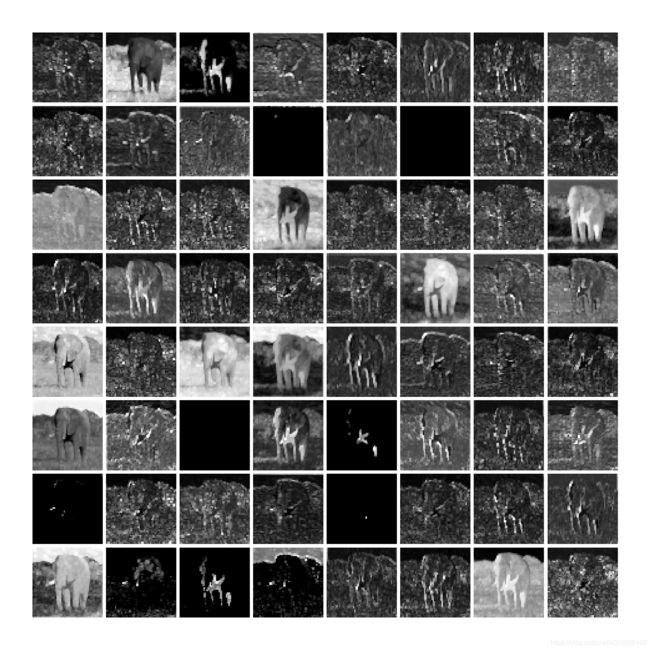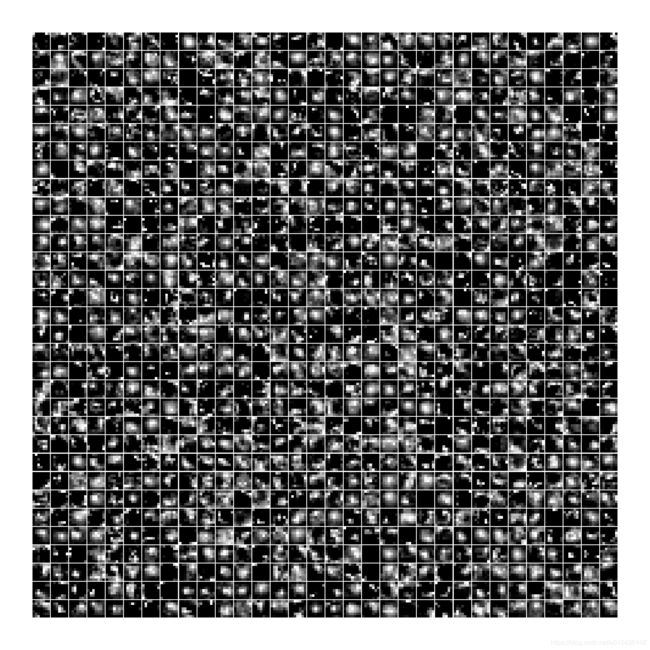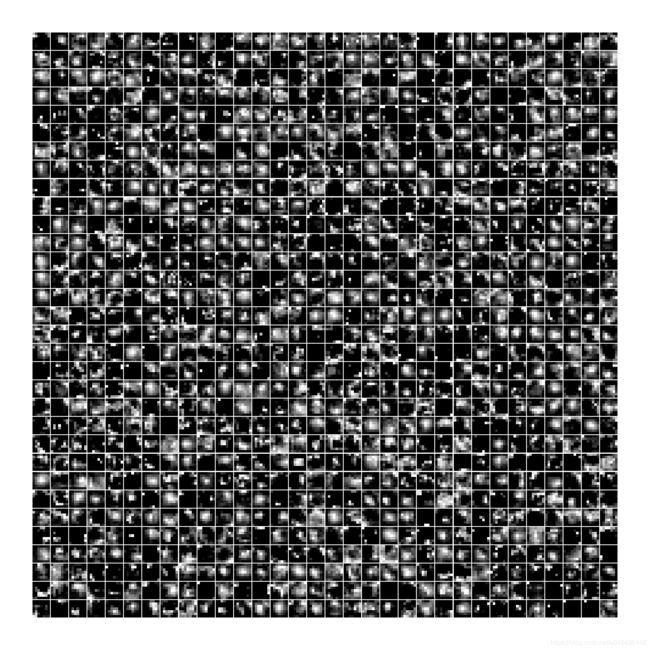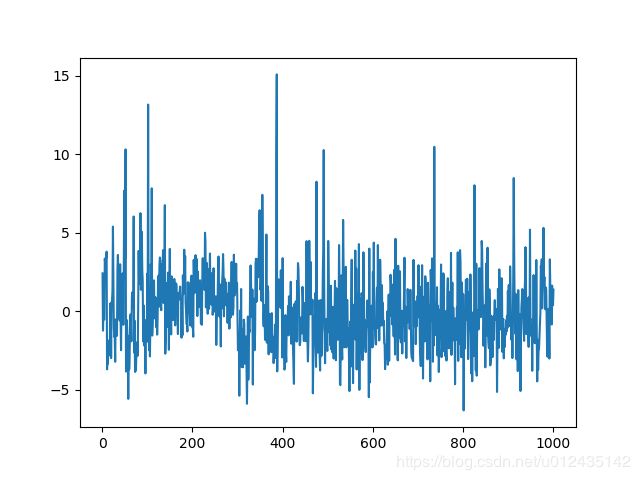Python可视化resnet50所有层特征图
Python可视化resnet50所有层特征图
使用pytorch中预训练模型,在网络inference的过程中显示特征图的每个通道.
文章目录
- 代码
- input image [1,3,224,224]
- conv1 [1,64,112,112]
- bn1_relu [1,64,112,112]
- maxpool [1,64,56,56]
- layer1 [1,256,56,56]
- layer2 [1,512,28,28]
- layer3 [1,1024,14,14]
- layer4 [1,2048,7,7]
- avgpool [1,2048]
- fc [1,1000]
代码
import cv2
import time
import os
import matplotlib.pyplot as plt
import torch
from torch import nn
import torchvision.models as models
import torchvision.transforms as transforms
import numpy as np
savepath='vis_resnet50/features_elephant'
if not os.path.exists(savepath):
os.mkdir(savepath)
def draw_features(width,height,x,savename):
tic=time.time()
fig = plt.figure(figsize=(16, 16))
fig.subplots_adjust(left=0.05, right=0.95, bottom=0.05, top=0.95, wspace=0.05, hspace=0.05)
for i in range(width*height):
plt.subplot(height,width, i + 1)
plt.axis('off')
# plt.tight_layout()
img = x[0, i, :, :]
pmin = np.min(img)
pmax = np.max(img)
img = (img - pmin) / (pmax - pmin + 0.000001)
plt.imshow(img, cmap='gray')
print("{}/{}".format(i,width*height))
fig.savefig(savename, dpi=100)
fig.clf()
plt.close()
print("time:{}".format(time.time()-tic))
class ft_net(nn.Module):
def __init__(self):
super(ft_net, self).__init__()
model_ft = models.resnet50(pretrained=True)
self.model = model_ft
def forward(self, x):
if True: # draw features or not
x = self.model.conv1(x)
draw_features(8,8,x.cpu().numpy(),"{}/f1_conv1.png".format(savepath))
x = self.model.bn1(x)
draw_features(8, 8, x.cpu().numpy(),"{}/f2_bn1.png".format(savepath))
x = self.model.relu(x)
draw_features(8, 8, x.cpu().numpy(), "{}/f3_relu.png".format(savepath))
x = self.model.maxpool(x)
draw_features(8, 8, x.cpu().numpy(), "{}/f4_maxpool.png".format(savepath))
x = self.model.layer1(x)
draw_features(16, 16, x.cpu().numpy(), "{}/f5_layer1.png".format(savepath))
x = self.model.layer2(x)
draw_features(16, 32, x.cpu().numpy(), "{}/f6_layer2.png".format(savepath))
x = self.model.layer3(x)
draw_features(32, 32, x.cpu().numpy(), "{}/f7_layer3.png".format(savepath))
x = self.model.layer4(x)
draw_features(32, 32, x.cpu().numpy()[:, 0:1024, :, :], "{}/f8_layer4_1.png".format(savepath))
draw_features(32, 32, x.cpu().numpy()[:, 1024:2048, :, :], "{}/f8_layer4_2.png".format(savepath))
x = self.model.avgpool(x)
plt.plot(np.linspace(1, 2048, 2048), x.cpu().numpy()[0, :, 0, 0])
plt.savefig("{}/f9_avgpool.png".format(savepath))
plt.clf()
plt.close()
x = x.view(x.size(0), -1)
x = self.model.fc(x)
plt.plot(np.linspace(1, 1000, 1000), x.cpu().numpy()[0, :])
plt.savefig("{}/f10_fc.png".format(savepath))
plt.clf()
plt.close()
else :
x = self.model.conv1(x)
x = self.model.bn1(x)
x = self.model.relu(x)
x = self.model.maxpool(x)
x = self.model.layer1(x)
x = self.model.layer2(x)
x = self.model.layer3(x)
x = self.model.layer4(x)
x = self.model.avgpool(x)
x = x.view(x.size(0), -1)
x = self.model.fc(x)
return x
model=ft_net().cuda()
# pretrained_dict = resnet50.state_dict()
# pretrained_dict = {k: v for k, v in pretrained_dict.items() if k in model_dict}
# model_dict.update(pretrained_dict)
# net.load_state_dict(model_dict)
model.eval()
img=cv2.imread('elephant.png')
img=cv2.resize(img,(224,224));
img=cv2.cvtColor(img,cv2.COLOR_BGR2RGB)
transform = transforms.Compose(
[transforms.ToTensor(),
transforms.Normalize((0.5, 0.5, 0.5), (0.5, 0.5, 0.5))])
img=transform(img).cuda()
img=img.unsqueeze(0)
with torch.no_grad():
start=time.time()
out=model(img)
print("total time:{}".format(time.time()-start))
result=out.cpu().numpy()
# ind=np.argmax(out.cpu().numpy())
ind=np.argsort(result,axis=1)
for i in range(5):
print("predict:top {} = cls {} : score {}".format(i+1,ind[0,1000-i-1],result[0,1000-i-1]))
print("done")






